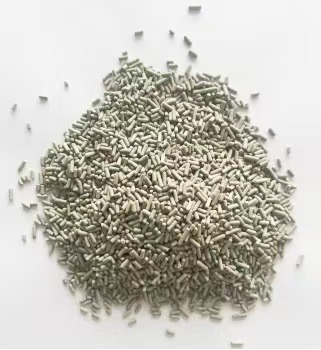
Products
Products

Isomerization Catalyst
Applications:
lsomerization Process
Process Introduction
C5 and C6 isomerization technology includes medium-temperature molecular sieve type isomerization technology, superacid type isomerization technology, and low-temperature chlorinated alumina type isomerization technology. Among them, the medium-temperature molecular sieve type isomerization technology features mild process conditions and mature technology. The molecular sieve type isomerization catalyst used in this technology has the characteristics of good stability, high yield, and strong impurity resistance, with its isomerization performance reaching the level of similar foreign catalysts. Currently, it has been commercialized in more than ten sets of devices at home and abroad.
Physicochemical Indexes of Isomerization Catalyst
|
Item |
Index |
|
Pt Content, m% |
0.34 ± 0.02 |
|
Specific Surface Area, m²/g |
>100 |
|
Crushing Strength, N/cm |
>100 |
|
Shape Size (Diameter × Length), mm |
Cylindrical φ1.5 - φ3 × 3 - 10 |
|
Bulk Density, t/m³ |
0.65 ± 0.05 |
Characteristics of Isomerization Catalyst

1. The use of composite molecular sieve carriers makes the acid distribution of the catalyst more reasonable, resulting in high isomerization conversion rates.
2. The unique platinum impregnation technology eliminates the mother liquor circulation process, resulting in a more uniform metal distribution and higher isomerization activity.
3. The catalyst has good stability, and the single-run cycle of the industrial device is 3 - 4 years.
4. The catalyst has good regeneration performance.
5. It can be combined with various separation technologies to form combined processes for producing products with different octane numbers, and the octane number of products can range from RON 80 to 90.
6. The catalyst has strong impurity resistance.
Dalian Chuangge Technology Co., Ltd
Richard Han
Doris Zhou
Headquater: 9th Floor, Century Classic Building, No.10, Xinghai Square, Shahekou District, Dalian City, Liaoning Province
Copyright: Dalian Chuangge Technology Co., Ltd. Business License Privacy Policy
Cookie
Our website uses cookies and similar technologies to personalize the advertising shown to you and to help you get the best experience on our website. For more information, see our Privacy & Cookie Policy
Cookie
Our website uses cookies and similar technologies to personalize the advertising shown to you and to help you get the best experience on our website. For more information, see our Privacy & Cookie Policy
These cookies are necessary for basic functions such as payment. Standard cookies cannot be turned off and do not store any of your information.
These cookies collect information, such as how many people are using our site or which pages are popular, to help us improve the customer experience. Turning these cookies off will mean we can't collect information to improve your experience.
These cookies enable the website to provide enhanced functionality and personalization. They may be set by us or by third-party providers whose services we have added to our pages. If you do not allow these cookies, some or all of these services may not function properly.
These cookies help us understand what you are interested in so that we can show you relevant advertising on other websites. Turning these cookies off will mean we are unable to show you any personalized advertising.





